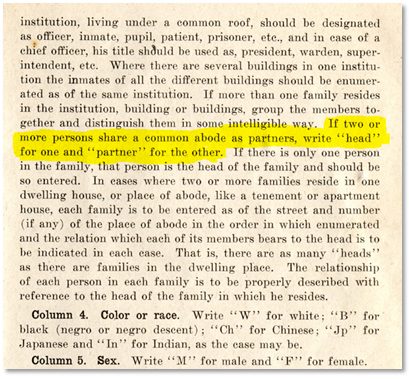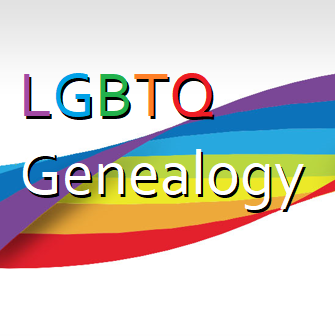The Term “Partner” in Census Records
The utilization of the term “Partner” in State and Federal census enumerations during the 20th century offers a unique window into diverse households. An illustrative example is the 1915 New York census entry for Anne Clark and Adele Albro, who were enumerated as Partners.
The term “Partner” was defined in the 1915 Instructions to Enumerators, stating, “If two or more persons share a common abode as partners, write ‘head’ for one and ‘partner’ for the other” (see Image 1). The 1940 U.S. Census instructions echo a similar definition, stating, “If two or more persons who are not related by blood or marriage share a common dwelling unit as partners, write head for one and partner for the other or others.”
Using Steve Morse’s census search tool, I quantified the occurrences of the term “partner” in 20th-century census records, ranging from 78,000 to 273,000 instances.
| Census Year | No. of Partners |
|---|---|
| 1950 | 273,958 |
| 1940 | 185,708 |
| 1930 | 78,915 |
| 1920 | 80,141 |
| 1910 | 112,256 |
| 1900 | 98,374 |
However, delving into these records reveals instances where “Partner” was used for unconventional living arrangements. In the 1940 U.S. Census in London, Madison, Ohio, we find an example of four nuns living together. Sister Mary Charles is listed as the “Head,” while Sister Mary Baptist, Sister Mary Anastasia, and Sister Mary Paschal are all listed as “Partner”. I’m not suggesting this was a four-way Lesbian relationship, but an example of extending the term beyond traditional relationships.
The term “Partner” also offers a glimpse into the relationship of movie stars Randolph Scott & Cary Grant in their 1940 enumeration (see Image 2). They lived together for 12 years in a beach house dubbed “Bachelor Hall” by Hollywood studios controlling their public and private image. The 1940 Census designates Randolph as the “Head” and Cary as the “Partner” (see Image 3). Although they denied being lovers, persistent rumors surround their relationship.
While the term “Partner” in the census is not foolproof for identifying same-sex couples, it has been employed that way by enumerators. As with any genealogical evidence, thorough interpretation and analysis are crucial. The enumeration of Scott & Grant aligns with census worker instructions, but only by considering additional evidence can we accurately place “partner” into the appropriate context.
In your searches, keep an eye out for the term “Partner” as a potential indicator of diverse household structures. Check out the blog post highlighting examples from the 1950 Census.







Some neighborhoods were more friendly to same sex couples than others. I’ve been helping with census data through familysearch and when I have found a partnership I’ve looked at the other nearby families. In the handful of entries that I have seen so far, all have have had other same sex partnerships on the same page. You can also look at their jobs to see if they are business partners and so far that has not been the case in the people that I have looked at.
In the1940 census, my great-aunt is listed as “wife” and her housemate is listed as head of house. I just found them today in the 1950 census, this time my great-aunt is listed as “head” and her housemate is listed as “partner.” I have often wondered if the census taker took liberties in 1940, or if they asked to be listed that way. There are other indications that they were a couple, the strongest being that my aunt wore an amethyst pinky ring, which was lesbian code for taken.
I really do not think the purpose of the census is to find out who is having a same sex relationship or other sexual relationship with others in the household, the purpose was to collect the legal relationship of unmarried persons within the household.
It is clear by the definition of partner as instructed to the census takers that the term partner for Randolph Scott & Cary Grant is accurate and there is no need to read anything further into it.
Hello Mary,
I agree the purpose of the census is to enumerate the population. However, the census, as with many other records, is used to glimpse the past. We can glean information on family structure, economic status, occupations, and also sexual relationships. When we see the enumeration of a Head of House, with a wife, and sons and daughters, we can infer these children came about from a sexual relationship. Though I disagree with your statement that “the purpose was to collect the legal relationship of unmarried persons within the household.” There is no legal relationship between unmarried persons, at least not informed by the census.
All genealogical records give us information about the past. We take each record in context with other records to correlate data and arrive at a reasonable conclusion. When we find a Head / Partner association in the census and have other records about that relationship hinting of a sexual relationship, we can infer that “partner” in this context meant sexual partner. Just as we identify heterosexual couplings, we can identify same-sex couplings.
I do believe that your understanding of what the purpose of the information gathered on a census was and your narrow view of what the response as “partner” is in the census is unfortunate. Partner could have referred to business partner, roommate etc. and that information would make more sense as an answer to relationship then what someone’s sexual relationship is with the other resident in the HH. And, It would not be wise to take that one bit of information and make a determination of ones sexual orientation from it without other supporting evidence especially because we know that census records can be incorrect and, again, the purpose of the census was not to record sexual orientation. One can imagine that that was not something discussed, disclosed or asked about in normal conversation let alone disclosed on a government form gathering that information.
It appears you have found a document to fit your narrative without following genealogical protocol and without common sense, you might want to consult with others to see if they would draw the same conclusion.
Hello Mary,
Please read my post above more carefully. See how I conclude the article – “Only considering other evidence will we be able to put “partner” into the appropriate context.
The term “Partner” is not a completely reliable means of identifying same-sex couples in the census, but it has been used by enumerators, so look for it in your searches.”
I do not believe I have a “narrow view” of the term partner in the Census. I can mean several things. But it can also mean a same-sex relationship. As with all evidence, genealogists must interpret documents in context with other documents to see how it fits into the family narrative. Please be open to the idea that your family tree, as everyone’s tree, as LGBTQ people. Seeing the term partner in a census may be a clue towards a person’s sexuality and it may not.
After doing further research and finding the instructions given to enumerators for the 1940 census, and referring to the column relationship was, “451. If two or more persons who are not related by blood or marriage share a common dwelling unit as partners, write head for one and partner for the other or others.” You can also infer from other answers instructed that the purpose of the answer was to determine the living arrangements not sexual orientation, otherwise, we would have to conclude that all two same sex people sharing a dwelling listed as partners in 1940 census were in a same sex relationship, and we know that is not the case.
Here is a link to the instructions as IPUMS USA website recording those instructions:
https://usa.ipums.org/usa/voliii/inst1940.shtml
I loved seeing one wonderful variation of “partner” in a 1910 census.
The location: RENO, NEVADA.
The time: APRIL 1910.
Following protocols, the enumerator (E.W. Holesworth) listed one man (an attorney, age 71) as “HEAD” of the household.
For the other man (a laborer, age 51), he wrote “PARDNER”.
A perfect word for the West.
(I have no idea of the nature of the relationship between the two men. They were not in the same household in 1900. The older man died in 1916.)
How would you interpret a Head of House; Partner of Sister; and the Head of House’s sister? I don’t want to assume a marital partnership between the Partner and the sister, but if they were true partners I would like to make them connected in my tree. No one from this family line is still around to ask. Thank-you for your blog. It is very informative.
Curious census record. I’d like to see if you could let me know the year, place, and family. Usually, all relationship descriptions in the census are based on the Head. Here you have a Head, Sister or Head, and Partner of Sister. The partner description does not relate to the Head. Am I understand this correctly? I wouldn’t assume a marital partnership here either, not yet. Can you find another census, documentation for the sister and partner? Is there anything else the might define what kind of partnership they had?
[…] the second example, we revisit Anne & Adele. You’ll remember them from the blog post on the use of the term partners in the census. Anne and Adele were listed as partners in the 1915 New York Census. The second image is that of […]
Thank you for your posts on this topic. I do both historical and genealogical research and have run into several instances where I strongly suspect that an individual was in a same sex relationship. I look forward to learning more about documenting and analyzing the evidence. I have also struggled with the how’s and why’s of including this information so I appreciate your very thoughtful comments on the topic.
I am particularly drawn to a great uncle who I believe isolated himself from the family for this very reason although at this point, I have very little if any evidence to point to. Can we learn from this, or otherwise provide information which is helpful to current and future generations. Should we account for what we may presume to have been the person’s desire to be private about their personal life?? Is speculation helpful here at all? I am also researching a historical figure, and the evidence there seems fairly substantial (lived and buried together) from the late 19th century to the early 20th century.
Again so many questions so I really appreciate learning more from you about this.
thanks.
My grandmother lived with her four children and another woman in Cucamonga, San Bernardino, California in 1940. She is head and the other woman was listed as partner. When I asked my aunts about this woman, they said she was a co-worker at a cafe. The meaning here was clearly that two unrelated adults were living in the same abode. Two months later my grandmother and children were in Napa, California. Loving your series!